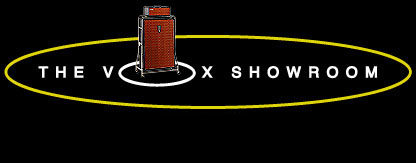|
The Vox guitar amplifiers manufactured by Thomas Organ in America incorporated innovative features and special effects not found in other amps from the mid 1960s. While many amplifier manufacturers were content to offer only reverb and tremolo, a number of American Vox amps included treble and mid range boost switches, a distortion effect, Repeat Percussion, E-tuner, and Tone-X. Outboard effects, such as the Wah Wah pedal, were also offered. Vox offered a plethora of ways to modify the amplified tone of an electric guitar.
Looking for new markets, Thomas Organ entered the band instrument business with their Vox "Ampliphonic" line. They hoped to bring the same spirit of innovation that powered their guitar amplification products to the "big band" stage. But their goal went beyond amplifying band instruments through a Vox amplifier. Thomas Organ also wished to develop outboard effects devices that would radically modify the tone of reed and brass band instruments just as MRB, fuzz tone, and Repeat Percussion had done for guitar.
To this end, Thomas Organ first sourced a line of brass and reed instruments that had the ability to mount an electronic "pickup" to send an audio signal from the horn to an amplifier.
After developing a line of unique Vox amplifiers that would accept the output from the pickups in their new band instrument line, Vox developed the pocket sized Octavoice I and II as "outboard" effects. This effect was designed to allow the amplified signal of the wind instrument to be dropped by one or two octaves. Here is how that was accomplished.
The electronic design of the Octavoice I and II was based on the tone generation circuitry used in Thomas and Vox organs. These organs used twelve circuit cards, each having a "master tone oscillator" that generated the highest pitched tones in the organ. The signal from each of these master tone oscillators was then fed serially through a number of octave "divider" networks. Each divider network would drop the frequency of the master tone oscillator by one octave. Through the use of five of these serial divider networks in each of the twelve tone generator circuit cards, the pitches needed to complete a five octave organ were derived.
The Octavoice I and II was inserted in the line between the instrument and the amplifier. The Octavoice substituted the signal from the brass or reed instrument pickup for the "master tone oscillator" in an electronic organ. The audio output from the instrument was fed through two serial divider networks, allowing the amplified pitch of the brass or reed instrument to be dropped one or two octaves.
The Octavoice I was primarily designed for use with a clarinet. It offered the ability to drop the amplified tones of the clarinet by one or two octaves, allowing the instrument to sound like a bass or contra bass clarinet. The Octavoice I also included tone filtering that shaped the tone of a clarinet to sound like an oboe.
The Octavoice II was primarily designed for use with a trumpet. It also offered the ability to drop the amplified frequency of the trumpet by one or two octaves, creating trombone and tuba like tones.
The Octavoice I and II were powered by a nine volt battery.
The Vox Showroom offers five additional resources for the Vox Ampliphonic Octavoice signal processors. Click on the links below.
2_Footer
|
© 1996 - 2024 The Vox Showroom, all rights reserved. No use on online auctions, eBay or Reverb.
|
|

